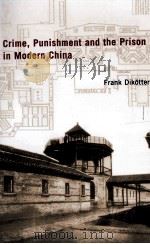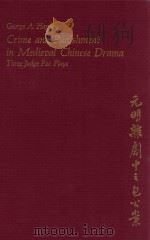《CRIME PUNISHMENT AND THE PRISON IN MODERN CHINA》
| 作者 | FRANK DIKOTTER 编者 |
|---|---|
| 出版 | COLUMBIA UNIVER SITY PRESS NEW YORK |
| 参考页数 | 441 |
| 出版时间 | 1893(求助前请核对) 目录预览 |
| ISBN号 | 0231125089 — 求助条款 |
| PDF编号 | 813700538(仅供预览,未存储实际文件) |
| 求助格式 | 扫描PDF(若分多册发行,每次仅能受理1册) |

1. INTRODUCTION1
The Prison in Modern History2
National Unity, Moral Education and Social Cohesion9
For a Cultural History of the Prison in China16
The Elusive Voice of the Prisoner22
Part Ⅰ. THE EMERGENCE OF A MODERN PENAL SYSTEM22
2. THE MOVEMENT FOR PRISON REFORM IN THE LATE QING (1895-1911)27
Imprisonment in Late Imperial China27
Monuments of Modernity: Foreign Prisons Observed34
The Movement for Prison Reform40
The question of extraterritoriality and China's first 'unequal treaty'41
Legal reform during the late Qing43
Shen Jiaben and the introduction of the custodial sentence46
Ogawa Shigejir? and the spread of penological knowledge50
The Emergence of Training Centres and the First Model Prisons53
The educative mission of training centres53
The emergence of the first model prisons56
3. CIVIL PRISONS IN EARLY REPUBLICAN CHINA (1911-27)59
The Ministry of Justice and prison reform61
The new criminal code62
Prison administration and the police62
The Ministry of Justice and prison reform64
The promulgation of prison rules and regulations66
Capital Crimes: Crime and Punishment in Beijing69
Foreign prisoners72
The educative mission of Beijing No. 1 Prison74
The expansion of the prison system in Beijing76
Crime and punishment in Beijing77
Property, sex, crime and imprisonment80
Criminal identification, the problem of recidivism and corporal punishment84
Prison staff and the maltreatment of prisoners88
Death in custody89
Ideal and reality in model prisons90
Prisons under the Beiyang Governments: The Examples of Fengtian and Jiangsu Provinces93
The expansion of new prisons93
Identification and composition of the prisoner population95
Sentencing patterns98
Punishments inside the prison101
Work and vocational training105
Religion and moral instruction107
Prison staff112
Finances and charity116
Escapes and riots122
Drugs126
Prison reform at the county level127
Disease and death129
Capital punishment136
Conclusion138
Part Ⅱ. SCIENCE, CRIME AND PUNISHMENT UNDER THE GUOMINDANG138
4. THE SCIENCE OF PUNISHMENT (1927-49)141
Introduction141
To Secure and Cure: Penal Philosophy in Republican China144
The educative mission of Sun Xiong and Rui Jiarui144
Zhao Chen and the virtues of the single cell148
The progressive stage system and the system of rewards153
The concept of self-government and the use of parole155
Penal discipline as a producer of social responsibility157
Li Jianhua and the example of the Soviet Union158
The Virtues of Industry: Work in the Prison162
Sex in the Prison164
Walls and Bars: The Silent Weight of Prison Architecture166
Wayward Children: Juvenile Correctional Policy172
The Final Punishment: The Debate over the Death Penalty178
5. THE SCIENCE OF CRIME (1927-49)182
'Homo Criminalis': TheRise of Criminology182
Heredity, Environment and Individual Responsibility in Criminology185
Born Criminals: Eugenics and the Biology of Crime193
The Measurement of Crime: Fieldwork in the Prison199
The Transparency of Crime: Yu Xiuhao and the Science of Criminal Investigation203
The Imprint of Crime: Criminal Identity, Fingerprints and Forensic Medicine209
Criminology and forensic medicine213
Part Ⅲ. PRISON REFORM UNDER THE GUOMINDANG213
6. PRISON REFORM IN THE NANJING DECADE (1927-37)219
The Ministry of Justice and penal administration under the Guomindang220
The Ministry of Justice220
Prison rules and regulations226
Crime, punishment and judicial statistics230
The expansion of the prison system232
Regional diversity of the prison system235
Life Behind Bars: Prisons during the Nanjing Decade241
Registration and identification of prisoners241
Prison labour247
The reclamation of wasteland250
Education and reformation252
Prison staff259
Overcrowding and the release of prisoners264
Escapes and riots269
Prisoner complaints271
The public image of prisons275
Disease and death276
Political Offenders and the Prison System280
Reformatories for political prisoners280
Political offenders in new prisons286
Prison Reform at the County Level295
Prison reform in Hunan and Zhejiang299
Prison reform associations303
Natural catastrophes and the county gaol304
Escapes305
Ward Road Gaol, Shanghai307
The Municipal Council and Ward Road Gaol307
Remission, overcrowding and the debate over judicial sovereignty310
Life inside Ward Road Gaol314
Foreign prisoners at the Amoy Road Gaol321
7. THE PRISON SYSTEM DURING THE WAR (1937-49)324
The Destruction of Prisons and the Release of Prisoners324
Death and destruction324
The release of prisoners327
Reconstruction and relocation of prisons329
Prison Reform during the War335
Dearth, disease and death337
The movement for productive labour342
The Red Cross and Prisoners of War345
Convict Colonies and the Reclamation of Wasteland349
Prisons in Occupied China352
Reconstruction after the War357
Expansion and overcrowding360
The Arrival of the Communists364
8. CONCLUSION369
Appendixes373
A. Modern Prisons373
B. Rules Governing the Administration of Prisons380
Bibliography393
Index423
Character List432
1893《CRIME PUNISHMENT AND THE PRISON IN MODERN CHINA》由于是年代较久的资料都绝版了,几乎不可能购买到实物。如果大家为了学习确实需要,可向博主求助其电子版PDF文件(由FRANK DIKOTTER 1893 COLUMBIA UNIVER SITY PRESS NEW YORK 出版的版本) 。对合法合规的求助,我会当即受理并将下载地址发送给你。
高度相关资料
-

- CRIME AND PUNISHMENT IN AMERICAN HISTORY
- 1993 BASIC BOOKS
-

- WIT AND HUMOUR IN MODERN CHINA
- 1993 NEW WORLD PRESS
-

- MODERN CRITICAL INTERPRETATIONS FYODOR DOSTOEVSKY'S CRIME AND PUNISHMENT
- 1988 CHELSEA HOUSE PUBLISHERS
-

- Crime and Punishment
- 1982 A BANTAM SKYLARK BOOK
-

- CRIME AND PUNISHMENT IN MEDIEVAL CHINESE DRAMA THREE JUDGE PAO PLAYS
- 1978 HARVARD UNIVERSITY PRESS
-

- CRIME AND PUNISHMENT FYODOR DOSTOYEVSKY
- 1967 AIRMONT PUBLISHING COMPANY INC
-

- CRIME AND PUNISHMENT IN ANCIENT ROME
- 1996 ROUTLEDGE
-

- CRIME AND PUNISHMENT CHANGING ATTITUDES IN AMERICA
- 1980 JOSSEY-BASSPUBLISHERS
-

- PUNISHMENT AND POLITICS THE MAXIMUM SECURITY PRISON IN NEW ZEALAND
- 1989 OXFORD UNIVERSITY PRESS
-

- WHEN BOXING WAS A JEWISH SPORT
- 1997 EXCELSIOR EDITIONS
提示:百度云已更名为百度网盘(百度盘),天翼云盘、微盘下载地址……暂未提供。➥ PDF文字可复制化或转WORD




